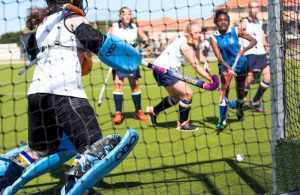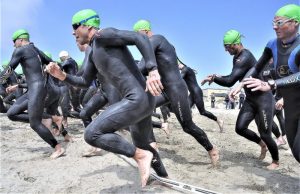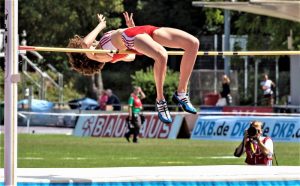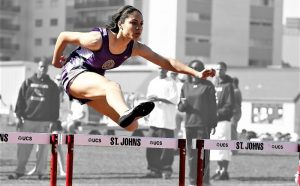Figure skating
Figure skating is a sport in which skaters on ice or on a track, alone or in pairs, perform jumping movements, turns, ascents and footwork in a graceful manner. Its name derives from the patterns skaters make on the ice, an element that was an important part of the sport until recently. There are several types of figure skating, including freestyle, couples, ice dancing, and synchronized team skating. The competition style, as well as the movements and techniques of the skaters, vary for each category of skating. Figure skating has become one of the most popular sports at the Winter Olympics.
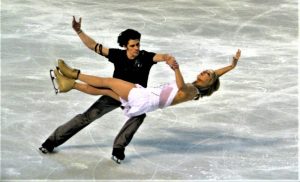
Related topics
Ice skating
What is figure skating?
Figure skating is a winter sport, although it can be done throughout the year in which athletes perform a piece of music skating on an ice track and performing acrobatics to the rhythm of the music.
About figure skating
The figure skating consists in the realization of a choreography for a musical piece skating on a track, in which a series of different movements, turns, jumps and acrobatics are realized, all of them to the rhythm of the music. Each movement has a punctuation and the technical and athletic aspects are qualified by the judges.
History
The history of ice skating originated in Holland during the 14th century. It arose from the need to cross the canals that were frozen during the winter, this situation made them start using skates with wooden blades. In 1572, the iron blades were created and seventy years later the first skating club was founded in Edinburgh.
In the 18th and 19th centuries, figure skating was considered a common pastime for monarchs and aristocrats, and in 1850 the American E. Bushnell introduced steel blades. Several years later, Jackson Haines began to introduce different elements of choreography and music to the skaters.
In 1879 the first artificial ice rink was built in England. In 1889 the first World Skating Championships were held in Holland for the first time. Sometime later the International Skating Union was created in Holland and then moved to Switzerland. It was introduced as a summer sport in London in 1908.
Rules
Among the general rules of figure skating we can mention the following:
- The age to participate is between 13 and 15 years and the maximum is 19 to 21 years.
- You must have the nationality of the country you represent or have lived there for at least one year.
- The judge is responsible for ensuring that the competition takes place in accordance with the rules.
- The judge will be in charge of the assistants, judges, timekeepers, schedulers and audio people in charge.
- The assistant must collaborate with the judge in all functions.
- After the presentation the judge or judges must make their evaluation and put a score.
- The person in charge of the track must be a member of the Board of Directors.
- The sound clerk must prove that the entire audio system is working properly.
- Delegates must represent the institutions in charge.
Modalities of figure skating
The modalities of figure skating are as follows:
- Mandatory figures: they are contained in the rules of the International Skating Federation. They must make circles on the rink and make three runs on each foot. They do not have an established body image pattern.
- Individual freestyle: it is executed following a musical rhythm, turns, steps, jumps and acrobatics are given. Harmony, rhythm and fluidity must be taken into account, as well as the style of the participants.
- Individual dance: an imaginary pattern is trace on the dance floor, basic dance movements such as displacements and runs are used to give greater fluidity to the choreographies.
- Free pair: formed by a man and a woman who synchronize their routines, with turns and jumps, elevations and acrobatics. The modalities depend on the category and level of the participants.
- Dance couple: it is performed by skaters of different sex, it is a freestyle routine and they must perform marching movements, waltzes, foxtrot, tangos and two-stet for example. It must be a routine full of harmony, spatial perception and creativity.
- Precision: the routine is done in groups of 12 skaters or 24 as maximum and is the assembly of a whole choreography that must be performed as uniformly as possible by the skaters.
- Show: it is performed by a group of skaters and they can use elements of free skating and pairs, they must dramatize the story or the rhythm that they have chosen previously. Costumes, makeup, accessories and music are very important
Jumps
The six main jumps of figure skating are:
- Axel, which can be double, single or triple.
- Loop or loop jump.
- Salchow.
- Flip or toe salchow.
- Lutz or chopped jump.
- Toe Loop also known as chopped loop.
Figures
Among the most important figures that must perform skating artists are:
- Cannon
- Knee
- Low Arabesque
- Stork or balance
- Death of the swan
- Angel
- Pigeon or arabesque
- Variation of pigeon
- Eagle
- Eagle one point up
- Two-pointed eagle on top
- Reversed
Track
The tracks must be in tile, granite, marble, cement or polished wood. The measures must be a minimum of 40 x 20 meters or a maximum of 50 x 25 meters and with deck or roof.
Figure skating equipment
The main accessories for figure skating are:
- Skates: they are the fundamental part of the sport and are made of leather boots.
- Blade: it is located under the skates and is made of tempered steel, or it can be two wheels in the case of skating on a cement rink.
- Dress: It must be adjusted to the athlete’s skin, but it must be comfortable at the same time.
- Protectors: Kneepads, helmets, gloves to protect joints should be used in some cases.
How to cite this article?
Briceño V., Gabriela. (2019). Figure skating. Recovered on 3 January, 2025, de Euston96: https://www.euston96.com/en/figure-skating/



